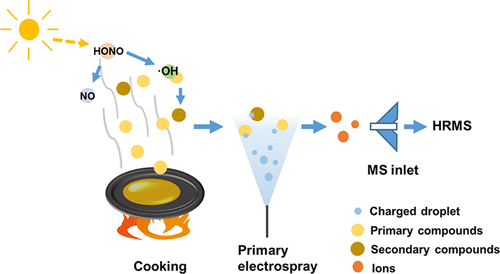当前位置:
X-MOL 学术
›
Environ. Sci. Technol. Lett.
›
论文详情
Our official English website, www.x-mol.net, welcomes your feedback! (Note: you will need to create a separate account there.)
Evolution of Indoor Cooking Emissions Captured by Using Secondary Electrospray Ionization High-Resolution Mass Spectrometry
Environmental Science & Technology Letters ( IF 10.9 ) Pub Date : 2020-01-27 , DOI: 10.1021/acs.estlett.0c00044 Jiafa Zeng 1 , Zhujun Yu 1 , Majda Mekic 2, 3 , Jiangping Liu 2, 3 , Sheng Li 2, 3 , Gwendal Loisel 2 , Wei Gao 1 , Adrien Gandolfo 4 , Zhen Zhou 1 , Xinming Wang 2 , Hartmut Herrmann 5, 6, 7 , Sasho Gligorovski 2 , Xue Li 1
Environmental Science & Technology Letters ( IF 10.9 ) Pub Date : 2020-01-27 , DOI: 10.1021/acs.estlett.0c00044 Jiafa Zeng 1 , Zhujun Yu 1 , Majda Mekic 2, 3 , Jiangping Liu 2, 3 , Sheng Li 2, 3 , Gwendal Loisel 2 , Wei Gao 1 , Adrien Gandolfo 4 , Zhen Zhou 1 , Xinming Wang 2 , Hartmut Herrmann 5, 6, 7 , Sasho Gligorovski 2 , Xue Li 1
Affiliation

|
Cooking emissions represent a major source of air pollution in the indoor environment and exhibit adverse health effects caused by particulate matter together with volatile organic compounds (VOCs). A multitude of unknown compounds are released during cooking, some of which play important roles as precursors of more hazardous secondary organic aerosols in indoor air. Here, we applied secondary electrospray ionization high-resolution mass spectrometry for real-time measurements of VOCs and particles from cooking peanut oil in the presence of 300 ppbv nitrogen oxides (NOx) generated by a gas stove in an indoor environment. More than 600 compounds have been found during and after cooking, including N-heterocyclic compounds, O-heterocyclic compounds, aldehydes, fatty acids, and oxidation products. Approximately 200 compounds appeared after cooking and were hence secondarily formed products. The most abundant compound was 9-oxononanoic acid (C9H16O3), which is likely the product formed during the heterogeneous hydroxyl (OH) radical oxidation of oleic acid (C18H34O2) or linoleic acid (C18H32O2). Real-time detection of an important number of organic compounds in indoor air poses a challenge to indoor air quality and models, which do not account for this extremely large range of compounds.
中文翻译:

二次电喷雾电离高分辨率质谱法捕获室内烹饪排放物的演变
烹饪排放物是室内环境中空气污染的主要来源,并表现出由颗粒物和挥发性有机化合物(VOC)引起的不利健康影响。烹调过程中释放出许多未知化合物,其中一些作为室内空气中更具危害性的二次有机气溶胶的前体发挥着重要作用。在这里,我们应用了二次电喷雾电离高分辨率质谱法,在存在300 ppbv氮氧化物(NO x)的情况下,实时测量了食用花生油中的挥发性有机化合物和颗粒。)在室内环境下由煤气灶产生。在烹饪过程中和之后发现了600多种化合物,包括N杂环化合物,O杂环化合物,醛,脂肪酸和氧化产物。蒸煮后出现约200种化合物,因此是次要产物。最丰富的化合物是9-氧代壬酸(C 9 H 16 O 3),这很可能是油酸(C 18 H 34 O 2)或亚油酸(C 18高32 O 2)。对室内空气中大量有机化合物的实时检测对室内空气质量和模型构成了挑战,而室内空气质量和模型并不能说明如此巨大的化合物范围。
更新日期:2020-01-27
中文翻译:

二次电喷雾电离高分辨率质谱法捕获室内烹饪排放物的演变
烹饪排放物是室内环境中空气污染的主要来源,并表现出由颗粒物和挥发性有机化合物(VOC)引起的不利健康影响。烹调过程中释放出许多未知化合物,其中一些作为室内空气中更具危害性的二次有机气溶胶的前体发挥着重要作用。在这里,我们应用了二次电喷雾电离高分辨率质谱法,在存在300 ppbv氮氧化物(NO x)的情况下,实时测量了食用花生油中的挥发性有机化合物和颗粒。)在室内环境下由煤气灶产生。在烹饪过程中和之后发现了600多种化合物,包括N杂环化合物,O杂环化合物,醛,脂肪酸和氧化产物。蒸煮后出现约200种化合物,因此是次要产物。最丰富的化合物是9-氧代壬酸(C 9 H 16 O 3),这很可能是油酸(C 18 H 34 O 2)或亚油酸(C 18高32 O 2)。对室内空气中大量有机化合物的实时检测对室内空气质量和模型构成了挑战,而室内空气质量和模型并不能说明如此巨大的化合物范围。



























 京公网安备 11010802027423号
京公网安备 11010802027423号